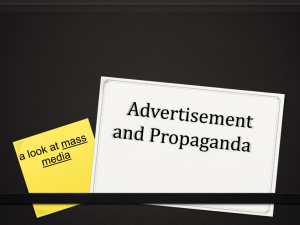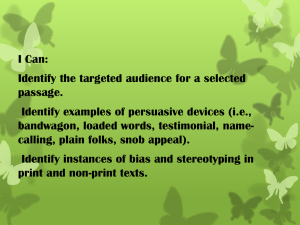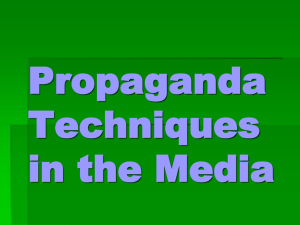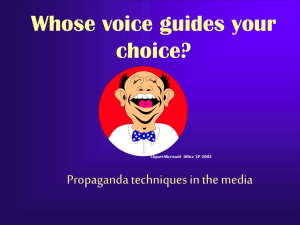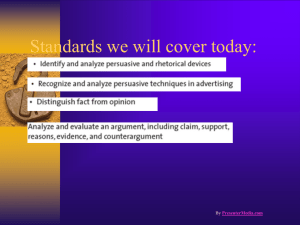Whose Voice Guides Your Choice
advertisement
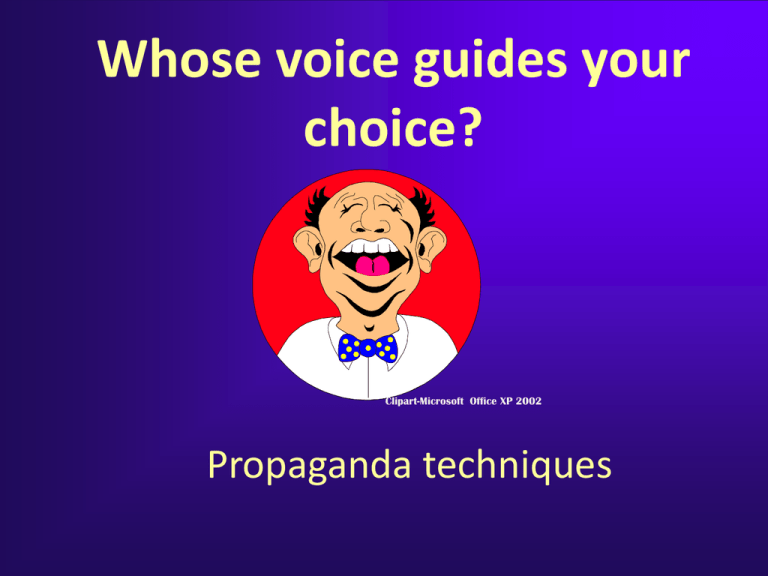
Whose voice guides your choice? Clipart-Microsoft Office XP 2002 Propaganda techniques Propaganda is … … form of communication … aimed at swaying or influencing your attitude … toward or away from some cause or position. Influence of Propaganda If you watch 30 hours of TV per week, you will… – View roughly 37,822 commercials per year • That’s about 100 TV ads per day You will see another 100 to 300 ads per day through other mass media If companies did not think you could be influenced, they would not spend billions of $ on it! So … if everyone is trying to influence you how do you …. How do you decide who is the best candidate… Clipart-Microsoft Office XP 2002 or which is the best toothpaste ? Clipart-Microsoft Office XP 2002 Who uses Propaganda? Media & Advertising: •Television •Radio •Billboards •Bumper stickers •Magazines, Newspapers Military Politicians Governments You and I What are Propaganda techniques? • Designed to persuade and to influence your Opinions Emotions Attitudes Behavior • Propaganda techniques seek to “guide your choice.” What are some of the methods or techniques used to persuade us? •Bandwagon •Name-calling •Testimonial •Glittering Generality •Plain-folks appeal •Transfer •Emotional words •Faulty Reasoning •Fear Bandwagon oEverybody is doing this. Join the crowd! You must JOIN in to FIT in! oIf you want to fit in, you need to “jump on the bandwagon” and do it too. Clipart-Microsoft Office XP Bandwagon example: Everyone in Auburn is supporting Bob Riley. Shouldn’t you be part of the winning team? Name-calling •A negative word or feeling is attached to an idea, product, or person implying that we should not be interested. Name calling example: Do we want a mayor who will leave us in debt? Spending grew 100% under Mayor Moneybags! Clipart-Microsoft Office XP 2002 Name calling example: In a campaign speech to a logging company, the Congressman referred to his environmentally conscious opponent as a "tree hugger." Testimonial & Endorsements •A famous person endorses an idea, a product, a candidate and implies the person uses it and so should we! Testimonial example: An important person or famous figure endorses a product. Testimonial example: If we drink milk we will all be as famous and as strong as superman. http://www.spreadingjam.com/wp-content/uploads/2009/08/superman-got-milk-ad-commercial1.jpg Cute Celebrities Target younger audiences Often use cartoons to sell a product The Ninja Turtles sell pizza, because they often eat pizza on the show http://www.lovefilm.com/lovefilm/images/products/6/21586-large.jpg Glittering Generality •Admired words like truth, democracy, beauty, timeless inspire positive feelings for a person, idea, or product. Makes you think positively about a product - catchy phrases - no guarantees - no evidence Glittering Generality example: If you want to be brighter, you’ll support Bill Brite. Clipart-Microsoft Office XP 2002 Look on the bright side! Vote for Bill Brite ! Glittering Generality example: Gatorade: "Life is a sport, drink it up!“ That sounds good, but what does it mean?? Plain-folks appeal This idea, product, or person is associated with normal, everyday people and activities. Plain folks Example: We want a Jim Smith, a mayor who supports the regular American worker. Clipart-Microsoft Office XP 2002 Vote for Smith Like a good neighbor… Plain folks Example: Transfer •Symbols, quotes, or images of famous people are used to convey a message to make you think you can be just like them! Transfer example: Good feelings, looks, or ideas transferred to the person for whom the product is intended. Transfer example: Joe uses symbols of America to tie his restaurant to American values for Independence Day. Celebrate the American Way this 4th of JulyEat at Joe’s Joe’s Barbeque Clipart-Microsoft Office XP 2002 Transfer example: http://www.automobilesreview.com/uploads/2008/11/built-ford-tough-2009-f-150.jpg …built American tough (Negative)Transfer Example: During the Kerry vs. Bush campaign an e-mail through the internet showed similar physical characteristics between John Kerry and a fictional character. Emotional words •Words that leave us with positive feelings are used to describe a product, person, or idea. •We associate those words and, therefore, those positive feelings with the product. Emotional words example: luxury, beautiful, paradise, economical Used to evoke positive feelings Flag (patriotism) Fun Happiness Emotional words example: What feelings are inspired by the words “true love”? If you wear this cologne will someone fall in love with you? True Love Clipart-Microsoft Office XP 2002 Slogan The origin of the term slogan is “a war cry or rally cry” (and is often used in political or patriot context), but it is commonly used to describe “a brief attention- getting phrase used in advertising promotion.” Jingle A phrase that “rhymes or sounds in a catchy manner,” which emphasizes its musicality, as being associated with a song or a tune. THE 20th CENTURIES TOP 10 COMMERICAL JINGLES 1. You Deserve a Break Today (McDonald’s) 2. Be All That You Can Be (U.S. Army) 3. Pepsi-Cola Hits The Spot (Pepsi-Cola) 4. Mmm Mmm Good! (Campbell Soup) 5. See The USA In Your Chevrolet (GM) 6. I Wish I Were An Oscar Mayer Wiener (Oscar Mayer) 7. Double Your Pleasure, Double Your Fun (Wrigley's Gum) 8. Winston Tastes Good Like A Cigarette Should (Winston) 9. It’s The Real Thing (Coca-Cola) 10.A Little Dab’ll Do Ya (Brylcreem) Source: Advertising Age Slogan TOP 10 SLOGANS OF THE CENTURY 1. Diamonds are forever (DeBeers) 2. Just do it (Nike) 3. The pause that refreshes (Coca-Cola) 4. We try harder (Avis) 5. Good to the last drop (Maxwell House) 6. Breakfast of champions (Wheaties) 7. Does she ... or doesn't she? (Clairol) 8. When it rains it pours (Morton Salt) 9. Where's the beef? (Wendy's) 10. Let your fingers do the walking (Yellow Pages) 11. M&Ms melt in your mouth, not in your hand (M&M candies) 12. We bring good things to life (General Electric) Fear •Tells us something to make us afraid •Suggests that the product or person will save us from some danger Fear example: If you use Safety Ware, it will keep people from stealing your identity – Clipart-Microsoft Office XP 2002 Guard against Identity theft Created the idea that you should worry about identity theft and that Safety ware will prevent it. Use Safety Ware www.safetyware.com Evidence Claims Facts and Figures – statistics to prove superiority. Magic Ingredients – suggests some miraculous discovery makes product exceptionally effective. Hidden Fears – suggests that user is safe from some danger. Evidence Claims: Will this help you reduce your cholesterol? http://repairstemcell.files.wordpress.com/2009/05/cheerios.jpg Trident: Four out of Five Dentists Evidence Claims: The viewer is led to believe one product is better than another, although no real proof is offered. Take the Pepsi Challenge Wit & Humor Travelocity's “ Roaming Gnome” campaign is based on the prank in which you steal your neighbor’s lawn gnome, take it to some exotic location, and send back photos of the gnome to the owner on top of some landmark. Wit & Humor So… How do we make sure that we are making informed choices, Clipart-Microsoft Office XP 2002 instead of allowing others to sway us in our decision-making? We make our own choices when … •we read and listen to reliable sources, •we watch for combinations of truths and lies, •we check for hidden messages, •we watch for use of propaganda techniques, •We think critically and, most importantly, www.scottish.parliament.uk/ educationservice WHEN WE LISTEN TO OUR OWN VOICES ! http://www.dkimages.com/discover/previews/844/10089620.JPG http://sharetv.org/images/i_am_weasel-show.jpg Be a conscientious consumer Know what devices are trying to influence you Then… Make an informed decision Critical thinking questions Who created/paid for the message? For what purpose was it made? Who is the ‘target audience’? What techniques are used to attract my attention & increase believability ? Who or what might be omitted and why? What do they want me to think or do? How do I know what it means? Where might I go to get more information? Critical thinking questions Who produced and/or paid for the message? What is the purpose of the message? Who is the ‘target audience’ ? What techniques are used to both attract attention and increase believability? What lifestyles are promoted and why? Does the message contain bias or stereotypes? Critical thinking questions Why is this message being sent? Who stands to benefit from the message? Who or what might be omitted and why? How might different people interpret the message differently from me? What can I do with the information I obtain from the message? What do you know; not know; like to know? Look for facts to back up your choice. Find out who is presenting those facts. Clipart-Microsoft Office XP 2002 Are they facts at all, or is the advertiser using propaganda techniques to persuade you? Clipart-Microsoft Office XP 2002
